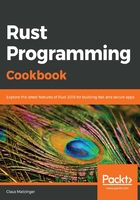
How it works...
This recipe played with several concepts, so let's unpack them here. After setting up a library to work with unit tests as our playground in step 1 to step 3, we create a first test to work on some built-in data types to go through the basics in step 4 and step 5. Since Rust is particularly picky about type conversions, the test applies some math functions on the outcomes and inputs of different types.
For experienced programmers, there is nothing new here, except for the fact that there is an overflow_sub() type operation that allows for overflowing operations. Other than that, Rust might be a bit more verbose thanks to the (intentional) lack of implicit casting. In step 5, we intentionally provoke an overflow, which leads to a runtime panic (and is the test result we are looking for).
As shown in step 5, Rust offers struct as the foundation for complex types, which can have attached implementation blocks as well as derived (#[derive(Clone, Copy, Debug)]) implementations (such as the Debug and Copy traits). In step 6, we go through using the type and its implications:
- No overhead on custom types: struct has exactly the size that the sum of its properties has
- Some operations implicitly invoke a trait implementation—such as the assignment operator or the Copy trait (which is essentially a shallow copy)
- Changing property values requires the mutability of the entire struct function
There are a few aspects that work like that because the default allocation strategy is to prefer the stack whenever possible (or if nothing else is mentioned). Therefore, a shallow copy of the data performs a copy of the actual data as opposed to a reference to it, which is what happens with heap allocations. In this case, Rust forces an explicit call to clone() so the data behind the reference is copied as well.
We've successfully learned how to create and use data types. Now, let's move on to the next recipe.